Senior Lunch Program Addresses Barriers to Health Beyond Hunger
The story was co-published with Black Voice News as part of the 2024 Ethnic Media Collaborative, Healing California.
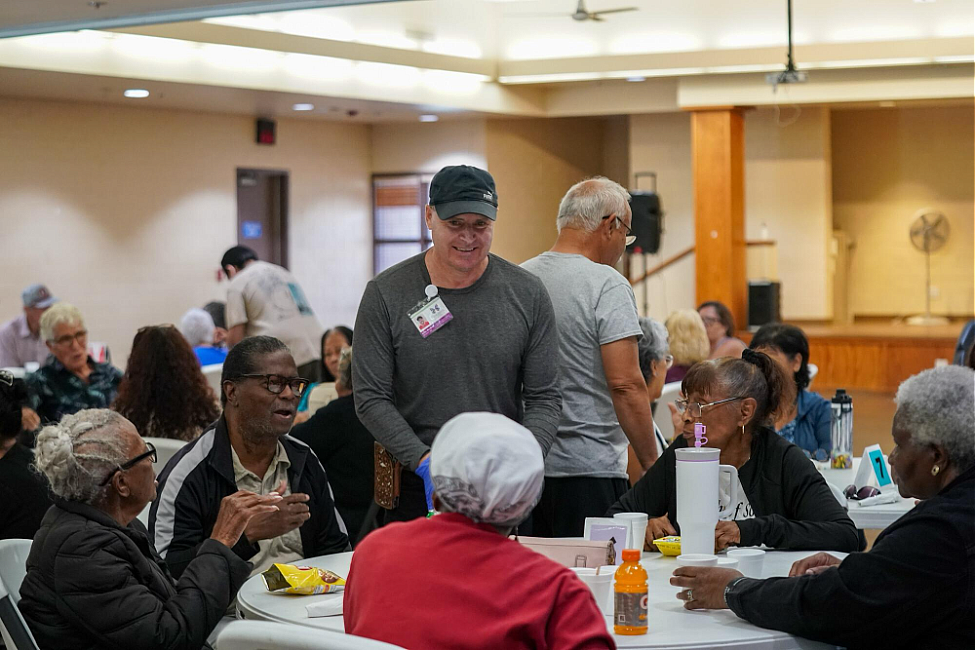
A staff member chats with participants of the senior lunch program before lunch is served the Moreno Valley Senior Center on October 7, 2024. Last year, Family Services Association (FSA) served 12,670 seniors across Riverside and San Bernardino Counties with 848,000 meals, through both in-person and home delivery lunch programs which run weekly. (Aryana Noroozi for Black Voice News/ CatchLight Local)
On any given day during the week, when the clock strikes 11:45 a.m, a large room in the Moreno Valley Senior Center begins to fill with people. Their voices grow from a hum to a buzz, the chatter of conversations are heard in both English and Spanish. On some days the room is filled with 90 seniors, on other days it’s up to 250. They come together and eat a variety of nutritious meals, but for many, the meals are not the reason they are there. The companionship is the reason they find themselves at the center up to five days a week.
In 2023, U.S. Surgeon General Dr. Vivek H. Murthy released an advisory to bring attention to the public health crisis of loneliness.
“Loneliness is far more than just a bad feeling—it harms both individual and societal health. It is associated with a greater risk of cardiovascular disease, dementia, stroke, depression, anxiety, and premature death,” wrote Dr. Murthy. Murthy likened the consequences of being socially disconnected on a person’s life span to smoking up to 15 cigarettes a day. Evidence also indicates that the risk of mortality is greater from lack of social relationships than from obesity.
Loneliness is not a condition with one clear causation. It can be measured by feelings of isolation and lack of companionship. There are varying factors that impact loneliness in older adults (those aged 50 to 80 years old). They can range from their gender, physical and mental health condition and the severity of these conditions, to limited daily activities and/or transportation, employment and living situations.
Other factors that increase risk of social isolation and loneliness include the loss of a partner or other loved ones, decreased mobility, worsening vision and hearing, chronic illness, lack of access to transportation and favorite activities.
Currently, across the Inland Empire there are just under a million older adults over the age of 60 – 390,000 in San Bernardino County and 531,000 in Riverside County, the California Master Plan for Aging estimates. Previous Black Voice News reporting highlights how the vast region is unprepared to accommodate its seniors and the dire need for services and visibility for this population, which will experience the highest growth rate of any other age group in the Inland Empire over the next twenty years.
Family Services Association (FSA), a local faith-based organization founded in Riverside, aims to address the epidemic of loneliness among older adults while working to mitigate another barrier to their health: food insecurity. For over 70 years, FSA has addressed senior hunger and nutrition through their senior lunch programs. Last year, FSA served 12,670 seniors across Riverside and San Bernardino Counties with 848,000 meals, through both in-person and home delivery lunch programs which run each week day.
The in-person senior lunch program takes place at community centers and spaces across both Riverside and San Bernardino Counties. The program is funded by contracts with the Riverside County Office on Aging and the San Bernardino County Department of Aging and Adult Services. However, these contracts cover only a portion of the actual costs of producing the high volume of meals, and the agency is reliant upon significant donations each year from private foundations and corporations to fully fund the program.
At the Moreno Valley Senior Center location – one of the busiest locations where up to 250 seniors are served on any given day – the food is just one draw. For the most part, seniors attend the lunch programs to socialize and for fellowship. In addition to socializing with their peers, they connect with the program and kitchen staff who speak in both English and Spanish to the group. To commence lunch, kitchen staff lead the group in the Lord’s Prayer.
Moreno Valley resident Shelley Davis, 75, has attended the lunch program every day for fifteen years and met a former boyfriend there. Meals offered at the lunch program vary from shepherd’s pie and broccoli to Asian chicken salad to chili relleno casserole to BBQ pork riblets. While these meals change from day to day, each meal attempts to provide a well-rounded nutritious meal. But for seniors like Davis, meals are ranked second to the companionship.
John Afolayan, 62, a Nigerian immigrant who has lived across the street from the center for over a decade, began attending earlier this year with a neighbor.
Both shared that eating a meal with others has improved their wellbeing and health.
“Since I started going to the senior center, I feel a lot better because after going through my divorce… for a time, I was in a little bit of depression,” Afolayan said. “I’ve met a lot of people over here I talk to. A lot of people [that] really make me feel better, [they’ve] uplifted my spirit, and makes me a lot better.”
For Afolayan, interacting and fostering community through the lunch program has been important, regardless of different cultural or racial backgrounds.
“We need to interact and relate to each other,” Afolayan said. “By doing that, you prolong your life, because by interacting with other people and talking to them and exchanging stories and this and that about family and stuff like that, it makes you see things in a clearer view with a better perspective.”
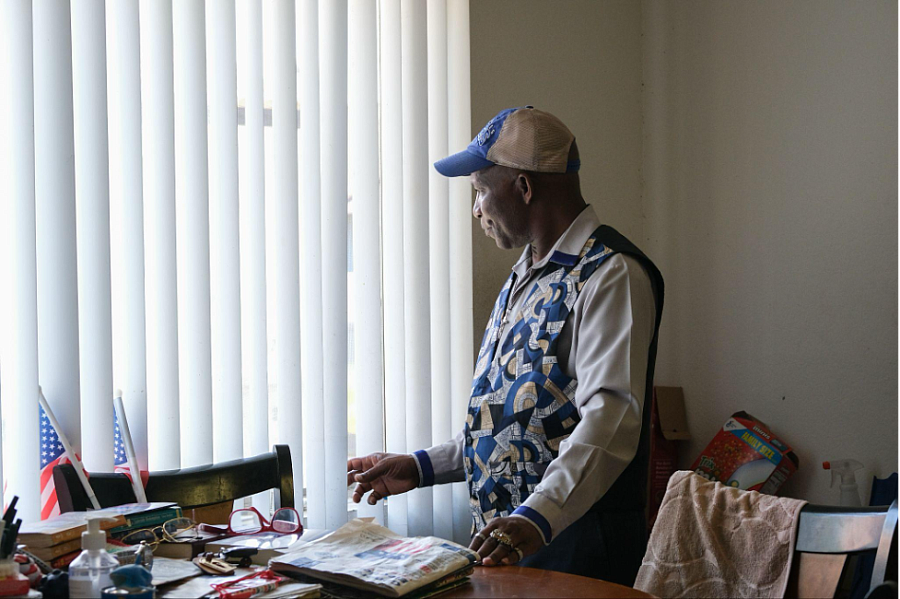
John Afolayan gazes out the window of his apartment in Moreno Valley, California on October 7, 2024. Earlier this year, Afolayan, who lives across the street from the Moreno Valley Senior Center, decided to check out the lunch program with his neighbor and has been coming daily since. Afolayan, an immigrant from Nigeria, says it’s not about the food — at home, he has enough food to feed a battalion he says — but about the social connection. After a divorce, and with his children living across the country, he says he enjoys spending time with others and coming together over a meal, sharing stories and things they have in common despite differences. “They make you feel more fulfilled, like at least you are living for other people, you’re helping other people to feel better about themselves, and you feel better in return,” he said. Family Services Association (FSA) serves meals to approximately 90 seniors at the senior center each day. An average of 450 meals are served daily across Riverside County through the weekly lunch program, along with approximately 850 meals served each day across San Bernardino County. (Aryana Noroozi for Black Voice News/ CatchLight Local)
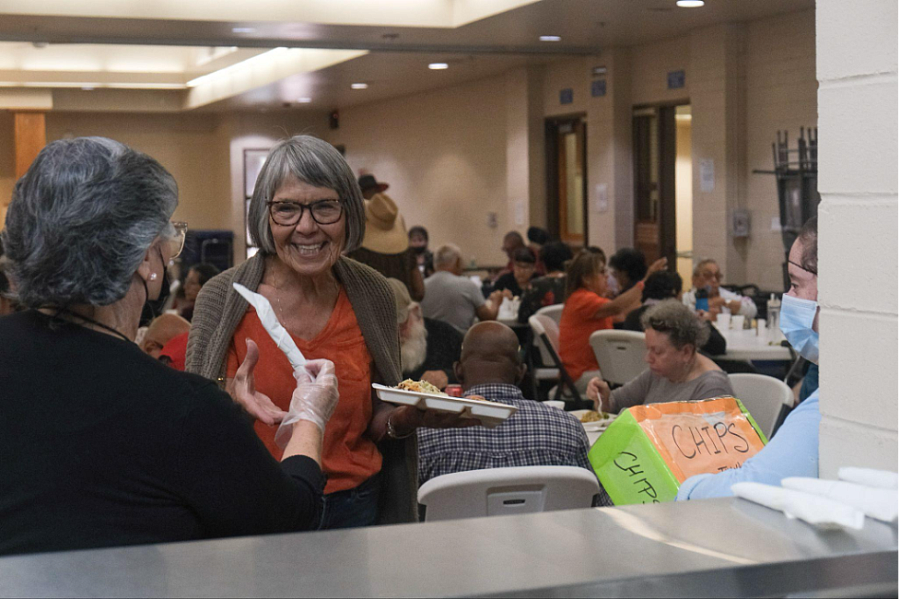
A staff member hands out utensils during the senior nutrition lunch program hosted by FSA every weekday at the Moreno Valley Senior Center on October 2, 2024. Of all of the FSA lunch program locations, the Moreno Valley Senior Center is one of the busiest, where up to 250 seniors are served on any given day (Aryana Noroozi for Black Voice News/ CatchLight Local)
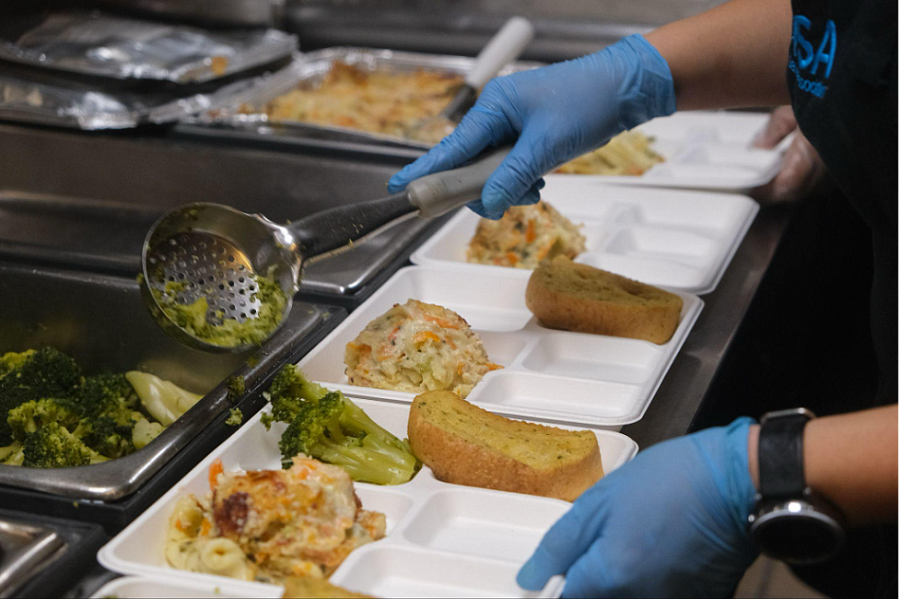
Staff prepare trays of vegetarian lasagna at the senior lunch program on October 2, 2024. (Aryana Noroozi for Black Voice News/ CatchLight Local)
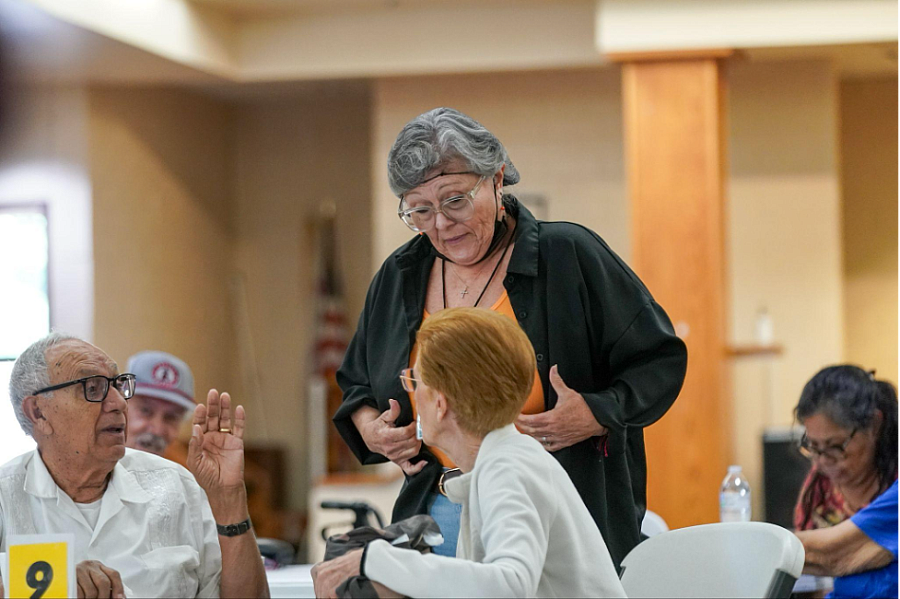
A member of the kitchen staff chats with attendees before a meal is served at the senior lunch program on October 6, 2024. (Aryana Noroozi for Black Voice News/ CatchLight Local)

A participant of the senior lunch program says the Lord’s Prayer before a meal is served at the senior lunch program on October 7, 2024. The prayer is said every day before lunch is served. (Aryana Noroozi for Black Voice News/ CatchLight Local)
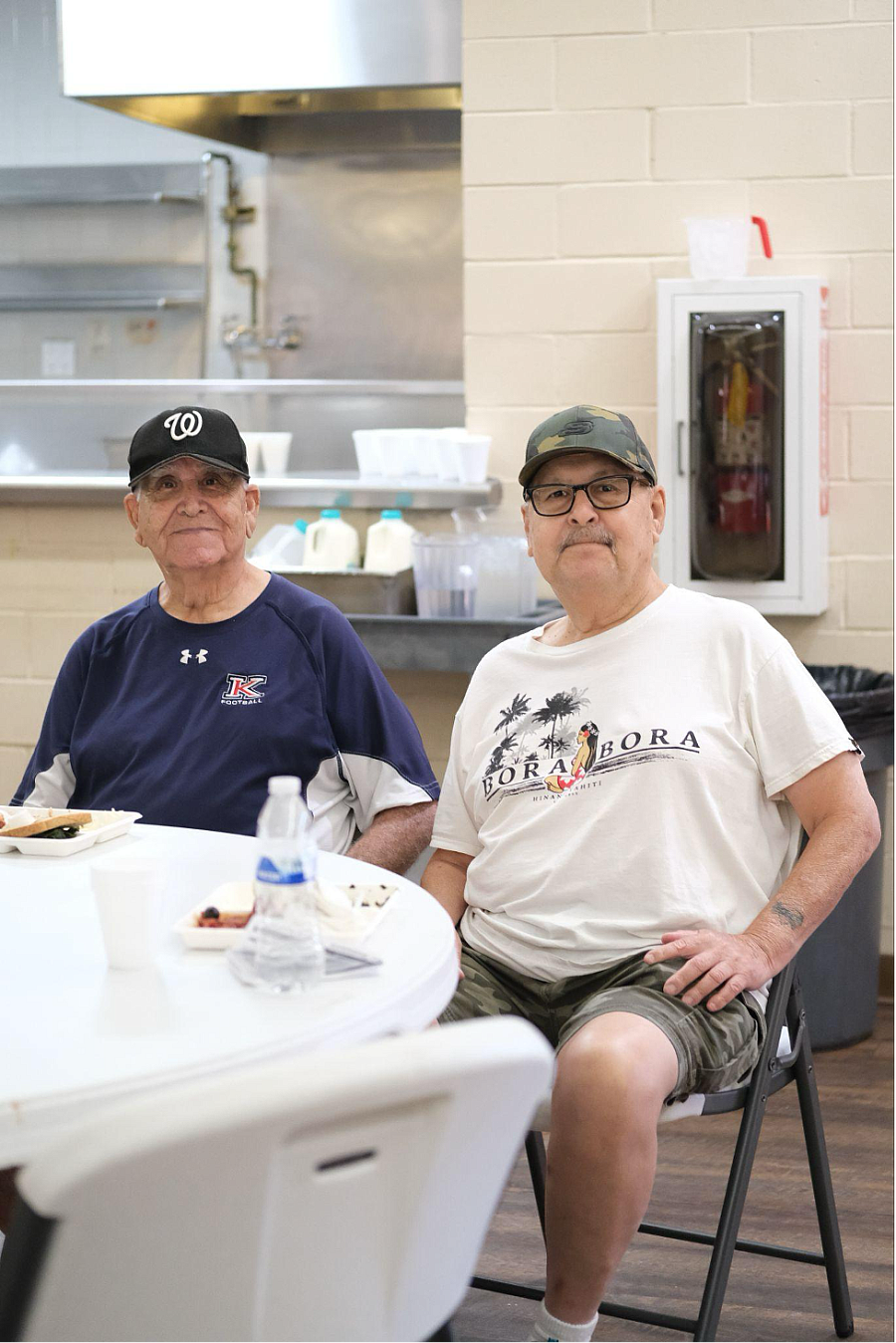
Rafael Sandoval and Enrique Avelar pose for a portrait at the senior lunch program on October 7, 2024. Sandoval, 88, has been attending the program for 10 years while Avelar has for five. When asked about the program, Sandoval said “amigos, amigos.”Avelar says that they come to meet friends and get together for lunch since many are home alone. “We come here to not eat by ourselves.” (Aryana Noroozi for Black Voice News/ CatchLight Local)

People socialize at the senior lunch program on October 7, 2024. (Aryana Noroozi for Black Voice News/ CatchLight Local)

Shelley Davis, 75, reads while she waits for other people to sit down shortly before lunch is served at the senior lunch program on October 7, 2024. Davis, who sits at the same table every day, was encouraged to begin attending the program by a friend who has since passed away. Now, Davis comes every day, citing socialization as the main reason. “The fellowship is number one. The meal is number two,”she said. If she could give advice to other aging adults it would be “Don’t stay in the house, get out.”(Aryana Noroozi for Black Voice News/ CatchLight Local)

People eat together at the senior lunch program on October 2, 2024. (Aryana Noroozi for Black Voice News/ CatchLight Local)
This Black Voice News project is supported by the USC Annenberg Center for Health Journalism, and is part of “Healing California,” a yearlong reporting Ethnic Media Collaborative venture with print, online and broadcast outlets across California.
